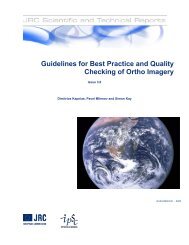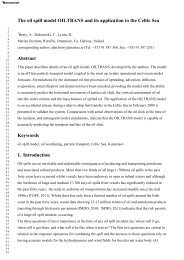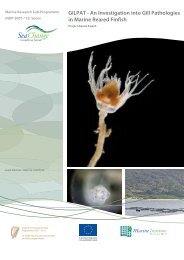PRESSING SEAWEED & ARTWORK
PRESSING SEAWEED & ARTWORK
PRESSING SEAWEED & ARTWORK
You also want an ePaper? Increase the reach of your titles
YUMPU automatically turns print PDFs into web optimized ePapers that Google loves.
Explorer Education Programme<br />
Lesson Plan: Pressing Seaweed & Artwork<br />
<strong>PRESSING</strong> <strong>SEAWEED</strong> & <strong>ARTWORK</strong><br />
Artwork © Cushla Dromgool-Regan, 2009<br />
Aim / Description:<br />
Discover seaweeds natural beauty by pressing seaweed and creating artwork and<br />
seaweed keys.<br />
Background:<br />
As the tide goes out on the rocky shore there is an array of colour. Look closely and<br />
notice how each tidal zone has its own colour, depending on the type of seaweed<br />
that lives there.<br />
Seaweeds are classified into three groups. These relate to their pigmentation<br />
colour:<br />
o red seaweed<br />
o brown seaweed<br />
o green seaweed.<br />
Depending on the season, the amount of sunlight and the age of the seaweed -<br />
these colours can vary. For example, brown seaweed can look green and red<br />
seaweed can looks maroon or dark purple.<br />
For marine related lesson plans, worksheets and activities see<br />
www.marine.ie
Explorer Education Programme<br />
Lesson Plan: Pressing Seaweed & Artwork<br />
Seaweed is a form of marine algae and has a vigorous life on the shore where it has<br />
to survive in salty water, crashing waves, tides and exposure to the heat and sun.<br />
Seaweed provides an important source of food and protection for a wide variety of<br />
marine animals as well as generating life and providing oxygen in the water.<br />
Unlike land plants, seaweeds lack roots, leaves, and stems but have other<br />
specialised structures. For example:<br />
• Instead of roots that reach down into the ground seaweeds have holdfasts<br />
which anchor them firmly to the rocks on which they live.<br />
• Instead of leaves seaweeds have a blade or series of branching fronds<br />
growing from the holdfast. Like leaves from seed-producing plants, the blades<br />
and fronds are the photosynthesising or food-producing parts of the plant.<br />
• Instead of stems seaweeds have stipes which absorb the shock of the<br />
crashing waves and tides. Some seaweeds have air-filled bladders that help<br />
their blades rise up towards the surface of the water, where they have a<br />
better chance of absorbing the sun's energy.<br />
• Seaweeds also produce a gelatinous substance that minimizes water loss –<br />
particularly when the tide is out.<br />
Seaweed Land plant<br />
Fronds………Leaves<br />
Stipe………………Stem<br />
Holdfast………………………Roots<br />
For marine related lesson plans, worksheets and activities see<br />
www.marine.ie
Explorer Education Programme<br />
Lesson Plan: Pressing Seaweed & Artwork<br />
Materials:<br />
• Basins<br />
• A4 sheets of paper<br />
• Paint brush<br />
• Pencil<br />
• Coloured cardboard<br />
• String/ribbon<br />
• Hole punch<br />
• Seaweed<br />
• Newspapers<br />
• Nappy liners (if available) / absorbent sheets<br />
• Paint /items for decorating the cover<br />
Activity:<br />
Step 1. Discuss the role seaweed plays in the rocky shore ecosystem. Introduce the<br />
vocabulary of seaweed - holdfast, stipe, blade / frond compare seaweed with land<br />
plants. Investigate the role seaweed plays in the rocky shore ecosystem.<br />
Step 2. Collect a range of seaweeds from the seashore. Try and find seaweeds that<br />
show different colours, texture and shapes which are located at the various zones of<br />
the seashore.<br />
If you look closely at seaweed you'll not only find an array of colour and some<br />
interesting adaptations for coping with waves and tides, but also some beautiful<br />
patterns. Enjoy discovering the patterns of marine algae by doing a seaweed print.<br />
Step 3. Divide up the seaweed amongst the students. The class will need to wait up<br />
until the seaweed has dried to create seaweed artwork.<br />
The students will be able to use the dried seaweed to make a variety of artwork<br />
such as:<br />
o seaweed keys (booklet)<br />
o a seaweed display board (i.e. showing the zones of where the different<br />
seaweeds are found on the seashore)<br />
o seaweed cards<br />
o seaweed collages and more.<br />
For marine related lesson plans, worksheets and activities see<br />
www.marine.ie
Explorer Education Programme<br />
Lesson Plan: Pressing Seaweed & Artwork<br />
Method:<br />
1. Select a piece of seaweed and wash it in (fresh?) water.<br />
2. Put the seaweed into a basin filled with (fresh?) water. It is a good idea to float<br />
the seaweed in the water until it opens up fully.<br />
3. Slip the A4 sheet of paper in the water underneath the seaweed.<br />
4. While still submerged, arrange the seaweed with the paint brush so as all the<br />
parts are visible.<br />
5. When you are satisfied with the presentation of the seaweed pull the sheet from<br />
the top out of the water, the seaweed should secure itself to the sheet. Seaweed has<br />
a natural gelatinous coating that acts like a glue.<br />
6. Tip the paper to drain off the water. Once you lift the paper, make sure you don't<br />
disturb the seaweed.<br />
7. Place the wet paper and seaweed on newsprint.<br />
8. Place a sheet of the nappy liners / absorbent paper over the seaweed.<br />
9. Press the plant between newsprint and weigh it down with a heavy object e.g.<br />
books. To help the seaweed dry out quickly and prevent it going mouldy, replace the<br />
dry newspaper sheets every one to three days.<br />
10. Leave pressing for at least 10 days until the seaweed is dry.<br />
11. When the seaweed is dry, label the page that the seaweed is stuck on with the<br />
following information:<br />
o the date it was collected<br />
o the location where it was found<br />
o type of seaweed it is<br />
o Label the holdfast, blade, and stipe on your seaweed.<br />
12. Compare the differences/similarities with a common land plant.<br />
13. When you have pressed a number of different type of seaweeds, combine the<br />
pages to make a book. Place a coloured sheet of paper at the front and the back of<br />
the collection. Punch a hole through pile of sheets and tie together with a piece of<br />
string/ribbon. The cover can be decorated using a seaweed theme and should<br />
include a title, the student’s name, class and date the book was produced.<br />
For marine related lesson plans, worksheets and activities see<br />
www.marine.ie

















